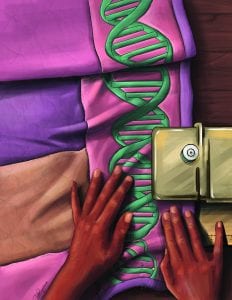by Paul W. Burridge, PhD

Paul Burridge, PhD, Assistant Professor of Pharmacology, Northwestern University Feinberg School of Medicine
The precision medicine revolution is upon us. The ability to collect a variety of patient data, computationally combine and process it, and algorithmically pinpoint a disease management or preventative strategy will profoundly change patient treatment. In the future your doctors will not only know which diseases you are most likely to experience, they will also know how an illness will progress, which drugs should be used for treatment, when and in which combinations, and whether you are likely to suffer side-effects from these interventions.
The wealth of information furnished by a patient’s genome makes genomic data a more valuable clinical tool than all other forms of patient information. With advances in DNA sequencing technology, and the cost of research-grade whole-genome sequencing (WGS) now only $600, there are no other precision medicine tools with such an extreme data-power-to-cost ratio. Genome sequencing is also a one-time cost, as your genome remains essentially the same throughout your life. Although the technology required to read a patient’s three billion base-pairs of genomic information is now cheaper and more readily accessible than ever before, our knowledge of how to interpret and act upon this wellspring of data is still profoundly lacking.
The central aim of the field of pharmacogenomics is to investigate the relationship between patient drug response and the genome. The primary pharmacogenomics research method so far has been the genome-wide association study (GWAS), in which DNA is compared from patients who either do or do not have a specific positive or negative drug response. We can then locate single base-pair changes in DNA called single nucleotide polymorphisms (SNPs) that statistically correlate with this difference in drug response. This methodology has been used on a large scale by companies such as 23andMe, where they have collected DNA from millions of subjects and asked them to complete questionnaires to self-identify phenotypes. Conveniently, these participants can be contacted repeatedly to ask questions further clarifying their phenotypes or to collect responses to additional phenotype questions that arise once genotype data have been analyzed. Of course, phenotype-genotype data collected by private companies is proprietary and is therefore not a resource available to the global research community.
About the Author
Paul Burridge, PhD, is an assistant professor in the Department of Pharmacology at Northwestern University Feinberg School of Medicine. Dr. Burridge began his career in genomics and bioinformatics at the Sanger Institute working on the human and mouse genome projects. He completed a PhD in Human Stem Cell Biology at the University of Nottingham before pursuing postdoctoral fellowships at the Johns Hopkins University in Pediatric Oncology and then at Stanford University in Cardiology before becoming an Instructor in Cardiovascular Medicine at Stanford. For more than 15 years, Dr. Burridge has worked on the applications of human pluripotent stem cells (both hESC and hiPSC), concentrating on culture and differentiation methodologies, regenerative medicine, and disease modeling, specifically the pharmacogenomic and molecular mechanisms of chemotherapy-induced cardiomyopathy and heart failure.
